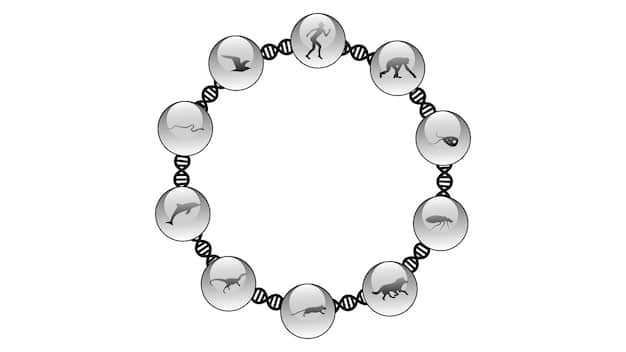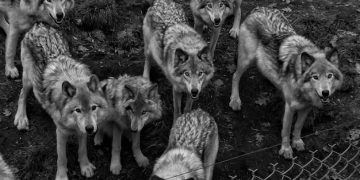The Role of Genetics in Animal Behavior: Temperament & Traits

Genetics significantly influences animal behavior by shaping inherited traits and temperaments, impacting everything from social interactions to learning abilities, providing insights into both domestic and wild animal behaviors.
Animal behavior is a fascinating field, often explored through the lens of nature versus nurture. However, understanding The Role of Genetics in Animal Behavior: Exploring Inherited Traits and Temperaments offers a deeper appreciation for how animals act and interact in their environments.
Understanding the Genetic Blueprint of Animal Behavior
The interplay between genetics and behavior is complex, but it’s clear that genes provide the foundational blueprint. This blueprint influences various aspects of an animal’s life, from physical characteristics to behavioral tendencies. Let’s delve into how specific genes contribute to these behavioral traits.
How Genes Shape Behavior
Genes encode proteins that affect the development and function of the nervous system. This directly impacts how an animal perceives its environment and reacts to stimuli. Variations in these genes can lead to differences in behavior, even within the same species.
The Role of Epigenetics
Epigenetics adds another layer of complexity. It refers to changes in gene expression that don’t involve alterations to the DNA sequence itself. Environmental factors can influence these epigenetic changes, further molding an animal’s behavior.

- Gene-Environment Interaction: Genes don’t operate in a vacuum. The environment plays a crucial role in how genes are expressed and how behavior is manifested.
- Polygenic Traits: Many behavioral traits are polygenic, meaning they are influenced by multiple genes, each contributing a small effect. This makes it challenging to pinpoint specific genes responsible for a particular behavior.
- Gene Mapping in Animals: Scientists use techniques like quantitative trait locus (QTL) mapping to identify regions of the genome associated with specific behaviors.
In conclusion, animal behavior is significantly shaped by their genetic blueprint, which includes both the direct effects of genes and the modulating influence of epigenetics. Understanding this genetic basis is vital for comprehending the diversity in animal behaviors.
Inherited Temperaments and Personality Traits
Temperament refers to an animal’s general behavioral style, which is largely influenced by genetics. This inherent disposition can affect how an animal responds to stress, interacts with others, and learns new tasks. Let’s explore how inherited temperaments manifest in different species.
Temperament in Dogs
In dogs, temperament is highly heritable. Breed-specific temperaments are well-documented, with some breeds known for their boldness and others for their shyness. However, individual variation exists within breeds, highlighting the role of both genetics and environment.
Temperament in Cats
In cats, temperament is also influenced by genetics, but it’s less predictable than in dogs. Some cats are naturally outgoing and affectionate, while others are aloof and independent. Early experiences can further shape a cat’s temperament.
The Role of Specific Genes
Certain genes have been linked to specific temperament traits. For example, genes involved in serotonin and dopamine signaling can affect an animal’s anxiety levels and social behavior.

- Heritability Studies: Heritability studies estimate the proportion of variation in a trait that is due to genetic factors. These studies have shown that temperament traits, such as fearfulness and aggression, are moderately to highly heritable.
- Selective Breeding: Selective breeding can alter temperament traits over generations. For example, the Russian silver fox experiment demonstrated how selecting for tameness can lead to changes in both behavior and physical traits.
- Environmental Influences: While temperament is largely genetic, environmental factors, such as early socialization and training, can modify an animal’s behavior.
In conclusion, inherited temperaments play a crucial role in shaping an animal’s personality and behavior. While genetics provide the foundation, environmental factors can either reinforce or modify these inherent tendencies.
The Genetics of Social Behavior
Social behavior is essential for the survival and reproduction of many animal species. Genetics play a significant role in determining how animals interact with each other, form social bonds, and establish hierarchies. Let’s examine how these social behaviors are influenced by genes.
Genetic Basis of Social Interactions
Genes involved in the production of hormones like oxytocin and vasopressin are critical for social bonding and pair formation. Variations in these genes can lead to differences in social behavior, such as the propensity to form monogamous relationships.
Social Hierarchy and Dominance
Social hierarchies are common in many animal species, with individuals competing for dominance and access to resources. Genetic factors can influence an animal’s ability to compete and establish its position in the social hierarchy.
Cooperative Behavior
Cooperative behavior, such as group hunting and alloparenting, is also influenced by genetics. Genes that promote prosocial behavior can increase an animal’s fitness in certain social contexts.
The vasopressin receptor gene, for example, has been studied extensively in prairie voles, which are monogamous. Variations in this gene affect the distribution of vasopressin receptors in the brain, influencing pair bond formation.
Moreover, studies on ants have revealed that specific genes are associated with worker behavior, such as foraging and nest building. These genes can affect the division of labor within ant colonies.
In conclusion, genetics underpin a wide range of social behaviors, from pair bonding to cooperative hunting. Understanding the genetic basis of social interactions provides insights into the evolution and maintenance of social structures in the animal kingdom.
Genetic Predispositions to Learning and Intelligence
Learning and intelligence are crucial for an animal’s ability to adapt to its environment. Genetics contribute to an animal’s cognitive abilities, influencing its capacity to learn new tasks, solve problems, and remember experiences. Let’s explore how genetic factors shape learning and intelligence in animals.
Genes Influencing Cognitive Abilities
Genes involved in brain development and synaptic plasticity are critical for learning and memory. Variations in these genes can affect an animal’s cognitive abilities, such as its ability to navigate its environment or learn from its mistakes.
Breed Differences in Intelligence
In dogs, breed differences in intelligence are well-documented. Some breeds, such as border collies, are known for their exceptional learning abilities, while others are less trainable. These differences are partly due to genetic factors.
The Role of Specific Brain Regions
The size and structure of specific brain regions, such as the hippocampus and prefrontal cortex, are also influenced by genetics. These brain regions play a crucial role in learning and decision-making.
- Maze Learning: Maze learning experiments are commonly used to assess an animal’s spatial learning abilities. Animals with specific genetic variations may perform better or worse in these tasks.
- Problem-Solving: Problem-solving tasks, such as opening a puzzle box, can reveal an animal’s cognitive flexibility and ingenuity. Genetics can influence an animal’s capacity to approach and solve these problems.
- Memory Tests: Memory tests, such as delayed matching-to-sample tasks, assess an animal’s ability to retain information over time. Genetic factors can affect an animal’s memory performance.
In conclusion, genetics play a pivotal role in shaping an animal’s learning and intelligence. While environmental factors, such as training and enrichment, can enhance cognitive abilities, the genetic foundation sets the stage for how well an animal can learn and adapt.
The Genetics of Aggression and Fear
Aggression and fear are fundamental behaviors that serve to protect an animal from threats. Genetics can influence an animal’s propensity to exhibit these behaviors, affecting its overall well-being and interactions with others. Let’s investigate how genetic factors contribute to aggression and fear in animals.
Genetic Factors in Aggression
Genes involved in the production of neurotransmitters like serotonin and dopamine can affect an animal’s aggression levels. Variations in these genes can lead to either increased or decreased aggression, depending on the specific gene and environmental context.
Genetic Factors in Fear
Genes involved in the stress response system, such as the hypothalamic-pituitary-adrenal (HPA) axis, can influence an animal’s fearfulness. Variations in these genes can lead to heightened anxiety and a greater sensitivity to stressful situations.
Breed-Specific Predispositions
In dogs, certain breeds are known for their higher rates of aggression or fearfulness. These breed-specific predispositions are partly due to genetic factors that have been selected for over generations.
For example, studies on mice have identified specific genes that are associated with defensive aggression. Knocking out these genes can reduce aggression levels in mice.
In addition, research on zebrafish has shown that certain genes can modulate fear responses. Overexpression of these genes can increase anxiety-like behavior in zebrafish.
In conclusion, aggression and fear are influenced by a complex interplay of genetic and environmental factors. While genetics can predispose an animal to exhibit these behaviors, environmental factors, such as early experiences and training, can modify their expression.
Ethical Considerations in Genetic Research on Animal Behavior
Genetic research on animal behavior raises important ethical considerations. It’s crucial to balance the potential benefits of this research with the need to protect the welfare of animals. Let’s discuss some of the key ethical issues in this field.
Animal Welfare
Genetic research may involve manipulating an animal’s genes, which can have unintended consequences for its health and well-being. It’s essential to conduct thorough risk assessments and minimize any potential harm to the animals involved.
Informed Consent
In research involving domesticated animals, it’s important to obtain informed consent from the owners. Owners should be fully informed about the purpose of the research, the procedures involved, and the potential risks and benefits.
Transparency and Accountability
Genetic research should be conducted in a transparent and accountable manner. Researchers should be open about their methods and findings, and they should be held accountable for any ethical breaches.
- Genetic Modification: Genetic modification of animals raises concerns about the potential for unintended health consequences and the disruption of natural behaviors.
- Selective Breeding: Selective breeding can lead to the exaggeration of certain traits, which may negatively impact an animal’s welfare.
- Data Privacy: Genetic data can reveal sensitive information about an animal’s health and behavior. It’s important to protect the privacy of this data and prevent its misuse.
In conclusion, ethical considerations are paramount in genetic research on animal behavior. By adhering to high ethical standards, researchers can ensure that their work benefits both animals and society.
| Key Point | Brief Description |
|---|---|
| 🧬 Genes & Behavior | Genes influence behavior by shaping the nervous system and responses to stimuli. |
| 🐾 Inherited Traits | Temperament and personality are largely genetic, affecting stress response and interactions. |
| 🤝 Social Genetics | Social behaviors are influenced by genes impacting hormones, hierarchies, and cooperation. |
| 🧠 Learning & Genes | Cognitive abilities are shaped by genes affecting brain development and learning processes. |
Frequently Asked Questions
▼
Genes encode proteins that impact the nervous system’s development and function, influencing how animals perceive and react to environmental stimuli.
▼
Inherited temperaments are an animal’s general behavioral style, largely determined by genetics, affecting responses to stress and social interactions.
▼
Genetics play a role in social behaviors by influencing hormones and the formation of social bonds and hierarchies within animal groups.
▼
Yes, genetics contribute to an animal’s intelligence and learning capabilities by affecting brain development and synaptic plasticity.
▼
Ethical concerns include animal welfare during genetic manipulation, obtaining informed consent for domestic animals, and ensuring data privacy.
Conclusion
In conclusion, the role of genetics in animal behavior is profound, shaping traits, temperaments, social interactions, and learning capabilities. Understanding these genetic underpinnings provides crucial insights into the complexities of the animal kingdom and raises important ethical considerations for future research.





